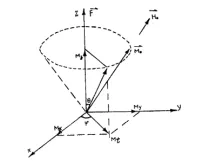拉莫尔方程
目录
简介
在电动力学中,拉莫尔方程用于计算非相对论点电荷在加速时辐射的总功率。 它首先由 J. J. Larmor 于 1897 年在光的波动理论的背景下推导出来。
当任何带电粒子(如电子、质子或离子)加速时,能量以电磁波的形式辐射。 对于速度相对于光速较小的粒子(即非相对论),粒子辐射的总功率(当被视为点电荷时)可以通过拉莫尔方程计算:P = 2 3 q 2 4 π ε 0 c ( v ˙ c ) 2 = 2 3 q 2 a 2 4 π ε 0 c 3 = q 2 a 2 6 π ε 0 c 3 = μ 0 q 2 a 2 6 π c (SI 单位) { displaystyle P={2 over 3}{frac {q{2}}{4pi varepsilon _{0}c}}left({frac {dot { v}}{c}}right){2}={2 over 3}{frac {q{2}a{2}}{4pi varepsilon _{0}c{ 3}}}={frac {q{2}a{2}}{6pi varepsilon _{0}c{3}}}=mu _{0}{frac { q{2}a{2}}{6pi c}}{text{(SI 单位)}}} P = 2 3 q 2 a 2 c 3 (cgs 单位){displaystyle P={ 2 over 3}{frac {q{2}a{2}}{c{3}}}{text{ (cgs units)}}} where v ˙ {displaystyle {dot {v}}} 或 a {displaystyle a} — 是固有加速度,q {displaystyle q} — 是电荷,c {displaystyle c} — 是光速。 Liénard-Wiechert 势给出了相对论的概括。
在任一单位系统中,单个电子辐射的功率可以用经典电子半径和电子质量表示为: P = 2 3 m e r e a 2 c {displaystyle P={frac {2}{3} }{frac {m_{e}r_{e}a{2}}{c}}}
一个含义是,如玻尔模型中那样,围绕原子核运行的电子应该失去能量,落入原子核,原子应该坍缩。 直到引入量子理论,这个难题才得以解决。
推导
推导 1:数学方法(使用 CGS 单位)
我们首先需要找到电场和磁场的形式。 字段可以写成:
E ( r , t ) = q ( n − β γ 2 ( 1 − β ⋅ n ) 3 R 2 ) r e t + q c ( n × [ ( n − β ) × β ˙ ] ( 1 − β ⋅ n ) 3 R ) r e t {displaystyle mathbf {E} (mathbf {r} ,t)=qleft({frac {mathbf {n} -{boldsymbol {beta }} }{gamma {2}(1-{boldsymbol {beta }}cdot mathbf {n} ){3}R{2}}}right)_{rm { ret}}+{frac {q}{c}}left({frac {mathbf {n} times [(mathbf {n} -{boldsymbol {beta }})times {dot {boldsymbol {beta }}}]}{(1-{boldsymbol {beta }}cdot mathbf {n} ){3} R}}right)_{rm {ret}}}
和 B = n × E , {displaystyle mathbf {B} =mathbf {n} times mathbf {E} ,} 其中 β {displaystyle {boldsymbol {beta } }} 是电荷的速度除以 c {displaystyle c} , β ˙ {displaystyle {dot {boldsymbol {beta }}}} 是电荷的加速度除以 c, n {displaystyle mathbf {n} } 是 r − r 0 {displaystyle mathbf {r} -mathbf {r} _{0}} 方向的单位向量,R { displaystyle R} 是 r − r 0 {displaystyle mathbf {r} -mathbf {r} _{0}} , r 0 {displaystyle mathbf {r} _{ 0}} 是电荷的位置,γ = ( 1 − β 2 ) − 1 / 2 {displaystyle gamma =(1-beta {2}){-1/2}} 。 右边的项在延迟时间 t r = t − R / c {displaystyle t_{text{r}}=t-R/c} 计算。

右侧是与带电粒子的速度和加速度相关的电场之和。 速度场仅取决于 β {displaystyle {boldsymbol {beta }}} 而加速度场取决于 β {displaystyle {boldsymbol {beta }}} 和 β ˙ { displaystyle {dot {boldsymbol {beta }}}} 以及两者的角度关系。 由于速度场与 1 / R 2 {displaystyle 1/R{2}} 成正比,因此它会随着距离的增加而迅速衰减。 另一方面,加速度场与 1 / R {displaystyle 1/R} 成正比,这意味着它随着距离的增加而衰减得更慢。 因此,加速场代表辐射场,负责将大部分能量从电荷中带走。
我们可以通过计算其坡印亭向量来求出辐射场的能量通量密度: S = c 4 π E a × B a , {displaystyle mathbf {S} ={frac {c}{4 pi }}mathbf {E} _{text{a}}times mathbf {B} _{text{a}},} 其中 a 下标强调我们是 只取加速场。